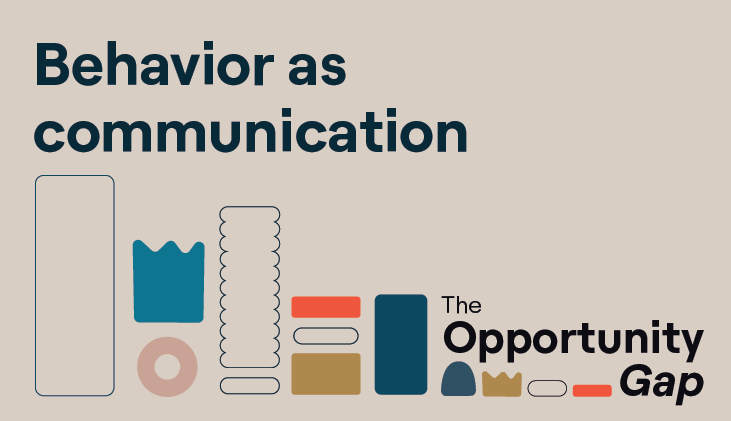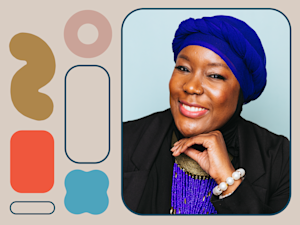Understanding your child’s behavior as communication

Stay in the know
All our latest podcasts delivered right to your inbox.
As in-person learning gets underway across the country, schools are seeing an increase in disengagement and even disrespect from some students.
After two years of learning online and often alone, socializing and sitting still in the classroom can be challenging for kids. Add in learning and thinking differences like ADHD, and it’s a recipe for behavior issues.
This week on The Opportunity Gap, hosts Julian Saavedra and Marissa Wallace challenge listeners to think of “misbehavior” as a form of communication. They share their experiences as educators and parents, and they offer their advice on how to help kids with their behavior.
Julian and Marissa also talk about how culture can determine which behaviors are seen as “good” or “bad.” And they discuss why so many kids of color are misunderstood by white teachers.
Related resources
Episode transcript
Julian: Welcome to "The Opportunity Gap," a podcast for families of kids of color who learn and think differently. We explore issues of privilege, race, and identity. And our goal is to help you advocate for your child. I'm Julian Saavedra.
Marissa: And I'm Marissa Wallace. Julian and I worked together for years as teachers in a public charter school in Philadelphia, where we saw opportunity gaps firsthand.
Julian: And we're both parents of kids of color. So this is personal to us.
What's going on, Marissa? How are you?
Marissa: I'm doing well. How about you? How is life?
Julian: I mean, life is good. I mean, can you believe how fast this year is going by, Marissa? It's crazy, right?
Marissa: It is definitely going fast, and, yeah, I don't, I don't think we're post-COVID yet. I think this is our transition year. That's what I've been calling it.
Julian: It's tread lightly and see what happens.
Marissa: Exactly. Take it day by day. That's all we can do.
Julian: But today we are going to really talk about some things that relate directly to a lot of people's experiences during the pandemic, primarily talking about the idea of student behavior and specifically student misbehavior, as students have been returning to in-person learning.
I know that all across the country, people have been reporting issues with student misbehavior. And so we want to talk a little bit about how it definitely is normal, and especially with our students with learning and thinking differences. But across the country, we've seen a giant spike in student misbehavior. And we've just got to figure out what's going on and what can we do as parents, as teachers, as adults to try to mitigate some of that.
Marissa, are you surprised? Is this something that you're experiencing? What are some of the things that you would consider falling under misbehavior?
Marissa: I'm not surprised. Behavior is something near and dear to what I've always thought about in some capacity, especially in the field of special education, and especially just knowing, and even like, prior to me getting into teaching, my undergraduate degree was in psychology, so I think a lot about behavior and how it impacts individuals and students, for sure. So I'm not surprised especially because, as you mentioned, right, the pandemic, whatever part of it we're at, whether a pandemic or not, it still is an intense two years, right, for all humans to experience just some drastic changes in society and life and how we operated on a day-to-day basis. So it's impossible for us to think that it's not going to impact kids. And it's impossible for us to think it's not going to impact kids in a school setting. The intensity and the frequency of what a lot of schools are experiencing with behavior is what I hope we can kind of discuss, dive into, uncover.
Julian: I always tell people that behavior is communication. It's a form of our students or our children trying to explain or express something that they're feeling. And instead of verbally saying it, they use their behavior as the way to share that. So once we, as the adults, can start to figure out what are they trying to tell us, or what is this behavior trying to communicate with us, then we can start to unpack the root causes for why it's happening.
But you know, let me ask, when we talk about the word "misbehavior," I think that's very loaded term. And it means different things to different people. What are some things that you consider misbehavior? Maybe we can see if you and I match up.
Marissa: To be honest, I don't personally use that term so much. For me, it's more or less what I'm thinking or talking about behavior, especially 'cause you said something important: one, the fact that it's communication, and two, also, I live by the idea that all behavior is learned. I just call it behavior. Like, to me, it's just behavior, right? So behavior is either going to get you to a place where you can achieve what you want to achieve in a positive way, or behavior is going to get you to a place where you're going to potentially not achieve something, or maybe you are going to achieve something that's a preferred, but that preference may not be the best thing for everyone around you.
There has been an uptick in some verbal conversations, whether that's with adults or with students, that are inappropriate or disrespectful. However, it's also behaviors such as task avoidance, like lack of engagement. Um, there's a lot of other things that I think, out of a place of anxiety or stress or trauma, that also impact a student's productivity or performance in school.
Julian: Glad that you threw in the distinction and the language of how behavior is sometimes subjective, and depending on who is viewing it, the person might look at it as a completely different way than somebody else might look at it. The idea that it's learned and that it comes from somewhere is a really important distinction to make. You know, we're seeing just not being where you're supposed to be, or potentially using devices like phones or computers or whatever, when you're not supposed to be using them, or even using them for inappropriate ways.
There's so many ranges of behavior that we're seeing that is very concerning, and it's not that they didn't happen before. It's just that it's happening a lot more frequently. And I think from what I'm seeing, it's also the reaction to redirection that's also increasing dramatically, right? Like where in prior years you might be able to say something to a child, and regardless of the relationship you have, most times they would comply with it pretty quickly. Whereas now we're seeing either a child will completely ignore the adult or they'll react in a really hyped-up, exaggerated form that might not have happened before. You know, I can speak candidly about my experience as an assistant principal at a high school and dealing with kids who — you talked about, trauma, there's tons and tons of traumatic events that our students have undergone — but I'm interested to know, what is it like with your situation as being a virtual teacher, working in an all-virtual school? What kinds of student behavior do you see?
Marissa: We have it, we are one of the largest districts in Pennsylvania, we have a ton of children that attend. And a lot of our students are really successful in our program. And because I do think that sometimes there's this idea that their child might've struggled behaviorally so they're going to try this virtual setting and that it's going to be a sweet ride. And that's not what happens, because behaviors just change. The setting changes, so the behavior changes. So what we see is like extreme disengagement, to the point where a student — we have something called overdue. So essentially you are expected to either attend your classes, your live and your guided instruction, either synchronously or asynchronously, and complete your lessons. And we have students who — I have a student who I think has almost 240 overdue lessons. Like I said, that task avoidance, the noncompliance, and then, and then from there, the other behaviors that we experienced a lot is in our Zooms, 'cause there are a lot of children in our classes and we know there's ways we obviously can navigate it because we can decide if our chats are open and that type of thing. But there is definitely a lot of cyberbullying that happens. Then, in addition to that, we've had different scenarios where there's been inappropriate pictures sent. And so there's been times we've had to shut down students' email addresses, like, can't use their school email because they were using it inappropriately.
And then we've had situations where there has been — sometimes students do get really smart and understand the technology more than I ever will. And they'll try to like be another student. So there'll be like imposters that happen as well.
Julian: So like catfishing, almost like catfishing on a virtual level. Interesting.
Marissa: Yeah. And those are some of the more extreme behaviors. So I think the one that we deal with the most though is just the lack of engagement. That's our number one behavior that we see is just 100 percent lack of engagement or off task. Like I even, I do meet with students individually, and I have some students who really have some learning and thinking differences in which it makes it very hard for them to focus. And so I, and they will be on camera with me and I will see them watching television and having their snack. They'll be doing 15 other things as opposed to being focused on what we're working on.
Julian: I don't envy you, if I'm going to be 100 percent honest. I think I'm going to talk a little bit about what we're experiencing in the in-person situation. But, you know, sometimes I miss the days of teaching in my sweatpants and looking at a bunch of blank screens.
Marissa: I mean, that's, the bonus.
Julian: And you know, it's not for everybody, but I imagine just the exhaustion that so many of our students are dealing with from doing it for so long, are those that did not experience it beforehand, but now they're doing it. Yeah. You know, I think that there's a very similar experience happening throughout the country and it's not exclusive to urban schools. It's not exclusive to suburban schools. It's not exclusive to private or across the country, where you either have one or two extremes. Either there's like extreme disengagement and apathy, where, similar to what you're talking about, where, you know, we have students that are not attending school.Like attendance rates have plummeted across the country. Schools that traditionally have 95 percent attendance or above, now you might see them having 75 percent attendance or 74, 73 percent attendance, which was very different than what they experienced before the pandemic.
And then once they are in school, at least at the high school level, many students are cutting classes, where the endurance of being inside of a classroom — especially in my school, we have block scheduling, right? So you're in a classroom for 97 minutes. And the endurance that it takes to sit and be in that space and be actively engaged in the learning for 97 minutes, four times a day, is just too much for a lot of kids. So, many of them just choose to skip, or might skip for 20 minutes or walk the halls.
I had a student this morning, actually, the mom came in and she was really worried about how his grades have plummeted from when he was in seventh grade. Because you know, a lot of our students, for — especially ninth graders, the last time they were in a brick-and-mortar school was when they were in seventh grade. So this is the, toward the end of his ninth-grade year, and his grades have plummeted from when he used to be an A student. And what we found is that he's skipping classes or, in some cases, going to class for 10 or 15 minutes and then asks to go to the bathroom, and then he'll just wander for a good 25 minutes. Just walk the halls by himself, you know, just kind of lost in his thoughts. And it took a while to get out, but he explains how he just feels so much anxiety. And we had to help him understand what that word meant, but he was like, "Mr. Saavedra, you know, I walk in there and it seems like everybody's staring at me. It seems like they're all waiting for me to mess up. And I don't know, you know, is it that they are staring at me, or is it not? And I just feel like I can't deal with it at this moment. And, you know, during the pandemic, I was just in my room all day and I got to do my work and then turn it off. And now I'm with all these kids and I don't know everybody, and it's even really hard, so sometimes I just leave class 'cause I need to get away from it."
And this is not a kid who's causing any big issues. He's just a really nice kid, but he went from being extremely social — mom said he used to play basketball. He was in the choir. He was in all these different activities in middle school. But now, two years later, he struggles to interact with other kids. And so his anxiety brings about this place where he just feels like he has to get away for a bit. We're seeing things like that all across the country.
The flip side is we're also seeing extremely, extremely egregious behavior that was not something that we saw before. You know, it's rough for across the board where there's just so many kids are choosing to do some of these more like violent acts towards each other, like fighting and, and getting into arguments really quickly, talking back to teachers, or just refusing to do the basic expectation of a classroom, where these are the same kids that a couple of years ago had never gotten in any trouble.
Marissa: Right. And I think as I was listening to you talk about both the student who's walking the halls out of anxiety and like fear of what could happen, or are they waiting for me to make a mistake, to talking about the more egregious things. I think one thing, and maybe a misstep on schools in general when we went back to in-person, was thinking to ourselves that we had to take some time to help our students relearn some of the behaviors of what it is to be around others and to be social. Because I do think that a lot of us didn't realize how isolated students were during the pandemic, like complete isolation.
Where just like that one kid was saying, like, he was pretty much left to himself for the entire day to do whatever. So they are missing that socialization that's, and especially at such integral times during their development, middle school and high school. Those times it's so key for them to be around their peers and to not have that and then to just be brought back into not only the academic pressures but the pressure of this social piece.
And here's the problem. Their social interaction during the pandemic, and even now a lot of times, was social media. It was TikTok. If that's what they're seeing, if that's what they're, if that's their main — especially if, when families were trying to navigate working and all of the things they were navigating at the time of when it was really in the thick of the pandemic, there was a lot left to children to just figure it out.
Julian: So I really want to think about, how do I put this, and I don't want to say just racial dynamic, but more so just cultural dynamic, right? Like there's a fact that 2 percent of the nation's teachers are Black men. And I'm one of them, right? The 2 percent of us are Black men, but the vast majority of schools are provided instruction by white women. We know that that causes cultural miscommunication sometimes. And like we said earlier, behavior is communication. You know, knowing that, I think you and I can both speak to the idea that sometimes there are miscommunications with behavior where a teacher, especially if the teacher does not share the same cultural background as the student, may mistake the way that the student is behaving as disrespect or as noncompliant, where in actuality, it's a cultural difference.
And in some cases there's implicit and explicit bias that comes into play. And what I mean by that is that specific example, there's cultural differences in the volume at which people speak sometimes, you know, and I'm just keep it a hundred, like sometimes Black folks, we get loud, we get hyped, we get loud with each other. We, and it's exciting, and it's a way that we communicate. It's part of what our — what we are. It's part of our culture. But I've been in places where the dominant culture of teachers was not that. And they wanted complete silence, and they wanted things to be calm and quiet and completely based on what the teacher was saying.And that was really hard for many, many of the students. And so if there had been more cultural understanding, if there had been more communication between each of the cultures involved, then maybe that might not have been mistaken for misbehavior. And so my question to you is, one, do you agree as a white woman who has been teaching in majority Black and brown schools, and, if and when that does happen, what's next?
Marissa: So I definitely agree with you. I think first and foremost, I agree with your sentiments and how you presented that. And I think, again, speaking with full transparency coming into education over a decade ago and coming into working in an environment where I was not the, the majority as I was used to being in my own spaces, right? I think it was a really important lesson for me to learn and for me to grapple with, especially in the early years. And I was really fortunate, because I was fortunate that I worked with a diverse staff. And so the staff that I was with, well, one, they were very honest and educated and able to provide what I felt was really appropriate professional development to have these hard conversations to talk about it.
I've seen situations where I know my child was misunderstood by a white female teacher, right? Like, and I have here, I have this student and he's young. So like, I think there's so many things that I've felt in his short career in education where there have been shortcomings where I've been, where I've had to advocate for him.
Like he's not — just because he put his pencil case down with a little bit of force does not mean he's aggressive. And this was an ongoing conversation that we would have almost on a daily basis when I picked him up. There was always some tidbit of his day that I had to hear about, right? Like, and that day was, it was just like, "He was really aggressive with his materials," and I'm like, but did he, I know I said to her, my response was, "Did he hurt someone?" She said no. "Did he hurt himself?" She said no. Well, he just needs to, he needs it. It's just what you were saying before, right? Like it was almost like he will go, and this was in preschool, so it was like this fear of him going into kindergarten and like that, him presenting in that way would make him an unruly kid.
And I'm like, he just, if he didn't hurt anyone, he didn't hurt himself, just because he put the pencil case on what you thought was in an aggressive way, like that is not OK.
Julian: Can you share why the word "aggressive," like why that might be triggering related to a Black boy?
Marissa: Absolutely. And I, and I would definitely not want to speak for my son or for any Black person, especially a Black boy. I know, though, as just mom of said Black son, it made me think of that's what society expects you to be. That's what society sees you as, another aggressive Black male. And that to me at the age of 5 is unacceptable, right? Like you're not going to label my child as aggressive when that is the word so commonly used to describe our Black males in our society.
Julian: The thing that people need to understand is that the language of how people describe behavior is really important. The language of how behavior is described as a lot of times where that understanding or miscommunication occurs. Hearing the word "aggressive," some of us might hear that and not really think anything of it, but when we hear that in relation to a Black boy at that age, we already know, all right, that's serious.
Now, coupled with that, this show is about the opportunity gap, and specifically about the intersection between race and learning and thinking differences. Think about your own experience as a learning support teacher, and now you are an expert, going to be Dr. Wallace pretty soon, I've seen this so much in my career. And I'll be honest, as assistant principal I've had to have some really difficult conversations with teachers about the miscommunication of how they perceive behavior from our students who have learning and thinking differences as disrespect or as blatant, blatantly not following directions, or it doesn't have any place in their space. Yet they haven't done the work to really understand how their learning and thinking differences impact what those behaviors are. So, you know, talk to me about that side of things. How is behavior misinterpreted sometimes with regards to learning and thinking differences?
Marissa: This is I feel like my life's work, right? I think that if I can like pinpoint the beginning of my career and knowing that my goal really was for all students, regardless of their learning and thinking differences, regardless of race — that they just received an appropriate education. Going back again, it's always about finding the root. So what is causing the behavior? It's usually not as hard as people think to figure it out. They're trying to avoid something, right? So the task avoidance is oftentimes what behavior is coming from. Or they're trying to self-soothe in some way. So you talked about that anxiety or those types of things. So they're doing something that makes them feel better in the moment as opposed to something that's a, and you know, in a nonpreferred activity or task which many might find hard. Or they're trying to do it for attention. Like it really boils down to a few reasons as to why the behavior is happening.
And once you know, no matter what it is, and anyone, learning or thinking difference or not, that's when you can start to problem-solve and address the behavior and change the behavior. It just takes time, Julian.
Julian: You know, as we're talking about the idea of, you know, this intersection with race, intersection of learning and thinking differences and you gave us a tip that we want to figure out the root cause. You and I have both been in situations where we've been on either end, whether it's somebody calling for our kids, or whether we are doing the calling or the emailing to contact the family about a situation that happened at school. "Can you come in for a conversation?"
There's a couple of steps that should be taken, right? If I'm a parent and I receive communication that, you know, my child has had a situation with their behavior at school, number one, I would listen to what it is, and I would immediately start having a conversation with the child as soon as they got home.
So I would ask them — and a lot of us want to go immediately to getting angry and to start fussing at my kid. And we've all done that, right? Like we, if a teacher calls me about one of my children not doing what they're supposed to do in second and first grade, I'm immediately going to be like, "All right, I need to get with you. What's going on?"
We have to resist the urge to get angry and to want to punish immediately and, to go back to what you said, have a conversation with the child: "Hey, I got an email from your principal, or I got a phone call from your teacher about this situation. Can you tell me what happened?" And when you have the conversation with the child, it's about asking lots of questions. "Tell me about it from your side of the story. Tell me what happened. Give me details. Why might they have called about this?" And a lot of times I'll advise parents to not share a bunch of what the principal or the teacher said, 'cause you really want to give the child a chance to share their own perspective. And that goes for a kindergartner all the way up to a senior in high school. Everybody should have a fair shot to share what they think and what they've experienced. And then once that communication has happened, then you can make a decision as to what you're going to do next.
Now, many parents may choose to then want more information from the school. "What happened? Tell me more. Can we schedule a meeting? Can we have a conversation about this?" And that's where you have to decide as the parent, what kind of communication is warranted from this scenario? If it's a cutting class situation, and I say that because in the high school level, like, we've had that situation happen a bunch of times. So depending on what the child says, then there might be no follow-up needed. It could just be, "Thank you so much, so-and-so, I appreciate you informing me. You should see a change by whenever." Or it could warrant, "We want to come in and have a meeting, and we want to discuss what's happening." And when you're going in for the meeting, it's really important to have a plan, have a game plan between you and whoever is coming in with you.
And so I always advise people to really think about what are the outcomes that you're looking for from this meeting? What are the outcomes that you're looking for from helping the behavior change? And understanding that your expectations for the child have to be really clear but also have to be filled with patience. It's not going to change immediately. And so, you know, resisting the urge to go immediately to consequence, but more so thinking about, what is the root cause? Why is this happening? Is it because you're anxious about going into class? Is it because you're meeting your girlfriend in stairwell seven? Is it because you're hungry and you're trying to get a snack from the store, it's, you know, what is it? Is it because you got to go to the bathroom more? Like, what, why are you doing this? And then once you figure out what it is, then you start to plan out actions accordingly. But really going in with, "This is a team effort. We're all going to be on the same page, the child included. I'm going to support you no matter what, I'm going to make sure that I am in your corner as your parent, but I'm also going to hold you accountable to my expectations."
And we as the school and the student and the family, we all need to be on the same page. And I'll be honest. I've seen some situations where parents come into school and they flip out. They get very angry or upset, and rightly so, there are some times where, you know, some, the kids, they push you to that edge and you get to that place. But there also are times when we as the administrators or we as the teachers know that this is all for show, like if this really was something that was happening, then all of this could have been handled at home. You don't need to do that in front of us, this meeting, and to all parents out there, whenever you're having conversations with schools, again, it's really about having a clear idea of what the outcomes are from the meetings. So when you prepare to walk into school, you and the child and whoever else is involved should preplan. We know that our students who have ADHD sometimes struggle with social cues. We know that our students with learning and thinking differences may struggle to have impulse control and they may struggle to not want to blurt out what they really feel at that moment. So anytime you have a chance to model how to have an appropriate, solution-driven conversation with another adult that directly involves that child, that's the best learning experience you could ever do.
Marissa: You're modeling it. That's what they're going to pick up on. I'm glad we're driving that point home and, Julian, like, you've said so many key things that it really flips the script so it's not a punishment, right? Like these are things we can actively and proactively do for our children to see that, and I think the other piece, when you were talking about the challenge sometimes with communication, with our students with learning and thinking differences, helping them to identify and feelings and use language, right? We sometimes have to give them the language, 'cause what happens if they don't have the language to express themselves, then they do it in other ways.
So I think that it's important for us to encourage them to name their feelings, encourage them to use dialogue, like you said, have those conversations, is making sure that we are consistently positively reinforcing what we want to see. So praising their efforts even at the smallest thing. That was one of the best things I ever learned was, you know, when you're, when you have a kid that you are struggling to work with, look for the smallest thing that they do well. If you think about how many times they hear what they do wrong, and they're just going to keep on doing that, that's all they're hearing. That's what they're hearing. That's what their takeaway is, that they, they aren't doing the right things in class. And then most of the time that's what they continue to do.
Julian: Sometimes you have to get angry, and sometimes it's hard not to. Especially parents out there. Look, I'm still stressed out. I'm sure all of you are still stressed. The pandemic is not over, and it's still a mess. It's still a lot going on. So it's hard to stay calm. I would challenge everybody listening, if you need to redirect, make it so that you calm yourself down first and you can focus on the action and not the person, especially for our students and our children with learning and thinking differences. They thrive, they absolutely thrive on specificity, and they thrive on consistency.
Julian: This has been "The Opportunity Gap," a part of the Understood Podcast Network. You can listen and subscribe to "The Opportunity Gap" on Apple, Spotify, or wherever you get your podcasts.
Marissa: If you found what you heard today valuable, please share the podcast. "The Opportunity Gap" is for you. We want to hear your voice.
Go to u.org/opportunity gap to find resources from every episode. That's the letter U as in Understood, dot O R G, slash opportunity gap.
Julian: Do you have something you'd like to say about the issues we discuss on this podcast? Email us at opportunitygap@understood.org. We'd love to share and react to your thoughts about "The Opportunity Gap."
Marissa: As a nonprofit and social impact organization, Understood relies on the help of listeners like you to create podcasts like this one to reach and support more people in more places.
We have an ambitious mission to shape the world for difference. And we welcome you to join us in achieving our goals. Learn more at understood.org/mission. "The Opportunity Gap" is produced by Andrew Lee, Cinthia Pimentel, and Justin D. Wright, who also wrote our theme song. Laura Key is our editorial director at Understood. Scott Cocchiere is our creative director. Seth Melnick and Briana Berry are our production directors.
Julian: Thanks again for listening.
Host

Julian Saavedra, MA
is a school administrator who has spent 15 years teaching in urban settings, focusing on social-emotional awareness, cultural and ethnic diversity, and experiential learning.
Latest episodes

April 10, 2024
Myths and misinformation about ADHD and learning differences show up all the time on social media. Find out what’s fact and what’s fiction, and learn about the impact of these myths on kids of color.

March 27, 2024
ADHD advocate René Brooks was diagnosed with ADHD twice as a child. But it wasn’t until she was diagnosed again as an adult that she finally got support. Listen to her story.

March 13, 2024
Learn about the steps to getting an IEP and starting your child’s special education program. Get tips from an expert.

February 14, 2024
Learn how four members of the Understood team are making an impact in the lives of people with learning and thinking differences.

January 31, 2024
How can high-schoolers and their families prepare for life after high school? Get advice and tips from a college advisor.

January 17, 2024
Some kids don’t like to share information about their school day. Get tips on how to get them to open up and share. These tips and conversation starters can help your child to open up.

January 3, 2024
The school-to-prison pipeline has disrupted education for kids of color for a long time. Learn what the pipeline is and why it’s critical to end it.

December 6, 2023
Telling your relatives about your child’s challenges can be difficult. Get tips on how to make the talk easier to manage.

November 8, 2023
For some students of color, feeling mistreated by teachers is a common experience — and it shouldn’t be. Learn how to help kids self-advocate.

October 25, 2023
Dyslexia is a common learning difference that impacts many kids of color. Hear from an expert and learn ways to support kids in the classroom.